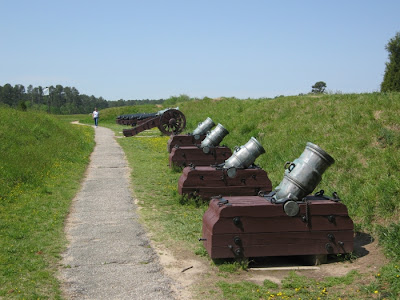 The town of Yorktown is very small and it looks like the houses and grounds have help from the National Park Service and/or the state of Virginia because everything is perfect and looks newly restored, newly painted and newly landscaped. Some of that may have come from reconstruction after the pounding this area took from hurricane Isabella in 2003, but today the streets are all nice brick paved, the curbs are all cut granite stone and the lawns and shrubs look like they all have the same good landscaper caring for them. There are quite a few original and restored original buildings like this house of Thomas Nelson, signer of the Declaration of Independence, participant in the battle of Yorktown and Governor of Virginia until 1781.
The town of Yorktown is very small and it looks like the houses and grounds have help from the National Park Service and/or the state of Virginia because everything is perfect and looks newly restored, newly painted and newly landscaped. Some of that may have come from reconstruction after the pounding this area took from hurricane Isabella in 2003, but today the streets are all nice brick paved, the curbs are all cut granite stone and the lawns and shrubs look like they all have the same good landscaper caring for them. There are quite a few original and restored original buildings like this house of Thomas Nelson, signer of the Declaration of Independence, participant in the battle of Yorktown and Governor of Virginia until 1781.
There is also the Colonial Grace Church, built in 1697. The walls are original, but the roof and interior were replaced after a fire in 1814. The church has been in continual use since 1697 and they're still using the original silver communion service made in London in 1649!

The battlefields at Yorktown are owned and operated by the National Park Service, so they're reasonably well preserved and taken care of. The earthen artillery fortifications here as well as the French siege cannon and the American field cannon are all original from the siege of Yorktown in 1781. What happened here was that British general Cornwallis had established Yorktown as a deepwater port for English ships. At the time, British forces in America were split between here and New York City, which they also controlled. George Washington decided that the war was "inconclusive" and he needed a major victory so he pulled the vast part of his forces down here as a surprise attack on Yorktown. When they were almost here, England found out and sent many warships here from NY, but the French navy had sent 24 ships to help the US independence cause and they stopped the British from reinforcing general Cornwallis here. Then, Washington's army, with 12,000 Americans plus Lafayette with 5,000 French and a few hundred German mercenaries sieged Yorktown and won.
The Park Service information shows that the help of the French was absolutely critical to winning this decisive battle. Kathy says that even though the French support was critical to the victory here in Yorktown, Washington could have won the overall war without the help from the French because in prior years he had to keep waiting for promised French help that usually didn't show up.
No comments:
Post a Comment